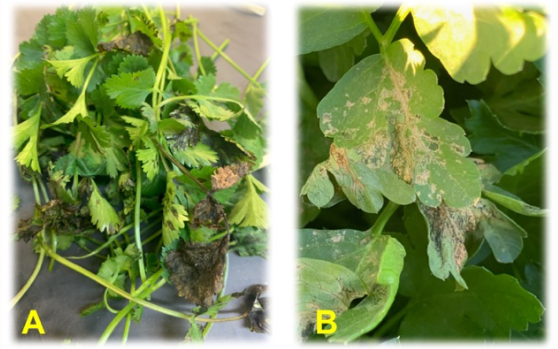Past week we had few reports of bacterial spot on cilantro and parsley. On both crops, initial symptoms of bacterial leaf spot are water-soaked lesions on leaves. The lesions develop into spots that are varying shades of tan or brown (see picture ‘B’on parsley whereas advanced spots on cilantro can be black (see picture ‘A’ on cilantro). The lesions are usually limited by leaf veins and thus have an angular, square, or rectangular appearance, a typical feature of bacterial infection. Lesions tend to be relatively small about 1/8 to 1/4 inch (3–6 mm) in diameter and are visible from both the top and bottom of leaves. Under favorable conditions, free moisture from rain or sprinkler irrigation, leaf spots may coalesce and cause considerable blighting of the entire foliage.
Pseudomonas syringae pv. apii (Psa) and P. syringae pv. coriandricola (Psc). cause bacterial leaf spot on parsley and cilantro. Pseudomonas syringae pv. apii (Psa) can cause leaf blight in celery and fennel as well. Though the problem is documented as more of a problem in cilantro and less in celery, in severe condition the disease can result in unmarketable produce in any host. The bacteria are likely seedborne in both crops. However, water from rain, sprinkler irrigation, and heavy dews and fogs will splash bacteria from infected plants onto adjacent healthy foliage resulting in heavy infestation.
To manage the disease, always use tested/treated seeds, rotate crop with non-host to reduce inoculum level, switch from sprinkler to furrow irrigation to limit secondary spread, avoid excessive use of nitrogen fertilizer. Copper spray/copper based fungicide provide limited control against the pathogens.
In next few weeks in the Clinic:
Join us for the 2020 preseason meeting on industrial hemp production on February 3rd at booth machinery at 9 AM for the workshop and listen to speakers on various topic on hemp production (See Agenda and Flyer).
And at 12:30 join us for the Field day at Yuma Ag Center, hemp trial field (follow signs, lunch provided).







